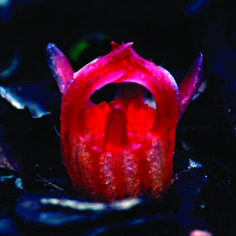Thismia rodwayi is a small reddish-yellowish flower without stem and leaves. It most often pops out of the forest floor or is hidden under the leaf litter. As it does not contain any chlorophyll, its only vegetative parts are a flower stalk and roots, both devoid of chlorophyll.
The flower is often called fairy lantern. Each individual plant usually sports only one flower, sometimes two, and they can be found in groups of two to five plants (but up to 12) in an area of less than 1 m2.

Although widely called a saprophyte, Thismia rodwayi is actually a non-chlorophyllous plant associated with a truly saprophytic fungus. The fungal hypha are found in the cortical cells of the plant’s roots, and also around those roots, mixed with humus.
Rotting organic material is absorbed by the fungus and stocked as fat globules in hyphal bladders. The fungal cells are then digested by the host, and the fat globules are turned into a polysaccharide possibly glycogen.

